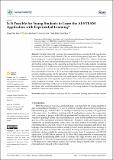| dc.contributor.author | Hsu, Ting-Chia | |
| dc.contributor.author | Abelson, Harold | |
| dc.contributor.author | Lao, Natalie | |
| dc.contributor.author | Chen, Shih-Chu | |
| dc.date.accessioned | 2021-10-12T20:18:51Z | |
| dc.date.available | 2021-10-12T20:18:51Z | |
| dc.date.issued | 2021-10 | |
| dc.date.submitted | 2021-09 | |
| dc.identifier.issn | 2071-1050 | |
| dc.identifier.uri | https://hdl.handle.net/1721.1/132945 | |
| dc.description.abstract | This study attempted to evaluate the learning effectiveness of using the MIT App Inventor platform and its Personal Image Classifier (PIC) tool in the interdisciplinary application. The instructional design was focused on applying PIC in the integration of STEAM (i.e., Science, Technology, Engineering, Art, and Mathematics) interdisciplinary learning, so as to provide sustainable and suitable teaching content based on the experiential learning theory for 7th grader students. Accordingly, the sustainable AI-STEAM course with the experiential learning framework has been implemented and verified, so as to confirm that the AI-STEAM course is not too difficult for young students. Many basic concepts involved in the AI-STEAM course, regarding programming logic, electromechanical concepts, interface design, and the application of image recognition, were measured in this study. The results showed that the students not only made significant progress in learning effectiveness, but also in particular made significant improvements in two parts: electromechanical concepts and image recognition knowledge. In the end, this study further provides some advice on the sustainable AI-STEAM course based on the survey of some important factors including active learning, and self-efficacy after confirming that it is not a barrier for the young students to learn the sustainable AI-STEAM course developed in this study. | en_US |
| dc.publisher | Multidisciplinary Digital Publishing Institute | en_US |
| dc.relation.isversionof | http://dx.doi.org/10.3390/su131911114 | en_US |
| dc.rights | Creative Commons Attribution | en_US |
| dc.rights.uri | https://creativecommons.org/licenses/by/4.0/ | en_US |
| dc.source | Multidisciplinary Digital Publishing Institute | en_US |
| dc.title | Is It Possible for Young Students to Learn the AI-STEAM Application with Experiential Learning? | en_US |
| dc.type | Article | en_US |
| dc.identifier.citation | Sustainability 13 (19): 11114 (2021) | en_US |
| dc.contributor.department | Massachusetts Institute of Technology. Department of Electrical Engineering and Computer Science | |
| dc.relation.journal | Sustainability | en_US |
| dc.eprint.version | Final published version | en_US |
| dc.type.uri | http://purl.org/eprint/type/JournalArticle | en_US |
| eprint.status | http://purl.org/eprint/status/PeerReviewed | en_US |
| dc.date.updated | 2021-10-12T14:18:09Z | |
| dspace.date.submission | 2021-10-12T14:18:09Z | |
| mit.journal.volume | 13 | en_US |
| mit.journal.issue | 19 | en_US |
| mit.license | PUBLISHER_CC | |
| mit.metadata.status | Authority Work Needed | en_US |
